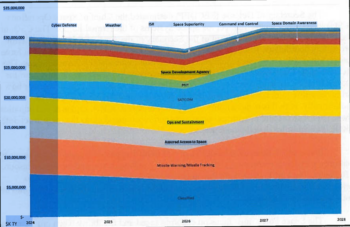
Next Generation Overhead Persistent Infrared missile warning/tracking satellite (Raytheon Intelligence & Space illustration)
WASHINGTON — The unclassified Space Force strategy delivered to Congress by Air Force Secretary Frank Kendall puts a spotlight on the new service’s support for the joint fight, in particular the role of the chief of space operations in coordinating space mission needs across all the services.
“The Space Force leads coordination with Combatant Commands to optimize Joint effectiveness and partner engagement to ensure complementary allied, commercial, and civil capability development,” explains the document, dated Aug. 15 but quietly released on Oct.13. Noting the need to “reduce unnecessary redundancies and maximize resource efficiency,” the strategy [PDF] stresses that the service “prepares implementation plans to unify disparate acquisition and sustainment authorities for space systems currently distributed across the National Reconnaissance Office, the Missile Defense Agency, Army, Navy and several Office of the Secretary of Defense elements.”
Congress demanded a “comprehensive” unclassified service strategy in the 2023 National Defense Authorization Act, including an explanation of the Space Force’s “strategic objective” and specific plans for its ground-based infrastructure, space architecture and a funding plan.
But despite the vow by the Biden administration to work to lower classification barriers surrounding all things military space, the document’s unclassified version is bereft of detail. Indeed, for those without access to the classified annex, the strategy mostly serves as a one-stop-shop for information up to now put out in dribs and drabs in speeches by senior officials, budget documents and Space Force announcements.
RELATED: Space Force chief seeks to ‘shift mindset’ to defend Joint Force on the ground

Space Force FY-24-28 funding plan by mission area.
The document does present a handy chart breaking out the five-year budget plan running from fiscal 2024 through 2028 into mission areas, although without specifying the precise amounts for each one. The chart shows a clear dip in planned spending from the FY24 request of $30 billion circa FY26, then a steady rise back to that level by 2028. Throughout that time-frame, missile warning and classified programs remain the largest spending pots.
The missile warning basket in particular shows substantial growth between 2026 and 2028, when the $14.4 billion Next Generation Overhead Persistent Infrared (Next-Gen OPIR) satellites will be launching and deliveries of the new Resilient Missile Warning/Missile Tracking satellites in medium Earth orbit will begin.
Among the other tidbits included in the unclassified version is a reminder that while US Space Command is the service’s “number one customer,” it also must fulfill the space requirements of the other combatant commands (US European Command, Indo-Pacific Command, etc.). To wit, it calls for “planning and exercise integration expertise, regional space activities like security activities with allies and partners and establishment of networks and procedures to disseminate missile warning to all forces in the theater regardless of dynamically shifting bases or disadvantaged communications positions in the theater.”
Further, the strategy states that the Space Force may be called on to provide regional jamming of adversary space communications to aid in missions such as personnel recovery, or “force protection of maneuver elements.”
L3Harris selloffs hampered by low bids, CEO says
“To the extent we can get a good price for what we’ve identified as non-core [businesses], we’ll do it. But too many of the offers are coming in low and people think we’re desperate to sell, and I can assure you we’re not,” said L3Harris CEO Chris Kubasik.



























